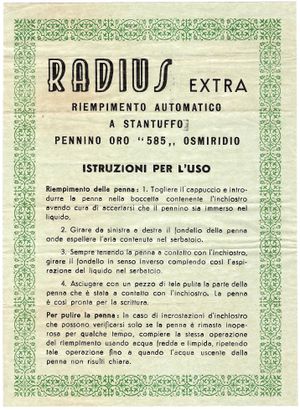Differenze tra le versioni di "Radius/en"
(Creata pagina con "thumb|A '50s [[Radius Extra instruction sheet.]]") |
|||
| Riga 8: | Riga 8: | ||
[[Image:Radius-Extra-Piston-Instr.jpg|thumb|A '50s [[Radius Extra]] instruction sheet.]] | [[Image:Radius-Extra-Piston-Instr.jpg|thumb|A '50s [[Radius Extra]] instruction sheet.]] | ||
| − | + | The [[Radius]] initial production was divided in two lines: the [[Radius Superior|Superior]] for the more valuable high-end pens and more valuable, and the [[Radius Extra|Extra]] for second tier pens sold at lower prices. The [[Radius Superior|Superior]] line remained in production, with different stylistic and technical changes, including the implementation of [[Radius Superior Trasparente|Trasparente]] version, until the '50s, while the [[Radius Extra|Extra]] line was decommissioned in the late '40s, replaced by other economic production, such as the [[Comet]] and the [[Radius 31]], [[hooded nib]] models of much lower quality than its predecessors. | |
[[Image:Radius-Superior-StriatedGray-Capped.jpg|thumb|left|Una [[Radius Superior]]]] | [[Image:Radius-Superior-StriatedGray-Capped.jpg|thumb|left|Una [[Radius Superior]]]] | ||
Versione delle 19:04, 26 ott 2014
The Radius brand is the one which is known for the highest quality SAFIS production, and is usually identified with this company. It was joined by the Astura brand, used for the second tier production. Though less known, it is the production of one of the most important Italian companies, and Radius pens, like its predecessors The King, are, at least for the production that took place in the golden age of company, of highest quality and have nothing to envy to the production of the most famous italian companies like OMAS or Aurora.
With the competition faced by the gradual spread of the ballpoint pen on the market, the quality of the production, especially in the last years of the company, got much worse, but after the war, the Radius has continued to produce pens celluloid good quality until the '50s and the production of this brand is still of great interest collezionistico.
| Radius |
|---|
| Brand pages |
| Brand advertising |
| Brand photos |
| Instructions sheet |
History
Around 1934 "The King Società Anonima Torino" was renamed in "Società Anonima Fabbrica Italiana Stilografiche", because of the policies of forced Italianisation of names carried out by the fascist regime,[1] which made it unattractive to use an English name. It is not known when the first pens Radius appeared on the market, and at the moment the only certain date is that of the trade mark registration (Reg. Gen. N. 50489) which occurred in 1934 by the new company, which is why we take this year as its starting date.

The Radius initial production was divided in two lines: the Superior for the more valuable high-end pens and more valuable, and the Extra for second tier pens sold at lower prices. The Superior line remained in production, with different stylistic and technical changes, including the implementation of Trasparente version, until the '50s, while the Extra line was decommissioned in the late '40s, replaced by other economic production, such as the Comet and the Radius 31, hooded nib models of much lower quality than its predecessors.
La produzione a marchio Astura era invece prettamente dedicata alla fascia economica e vede una enorme varietà di modelli realizzati con i più vari sistemi di caricamento e le più varie forme, in una sorta di sperimentazione sia tecnica che stilistica.
La produzione viene fatta risalire al periodo che va dagli anni '30 alla metà degli anni '50. Pur essendo chiaramente penne di fascia bassa sono interessanti in particolare particolare le versioni dotate di un particolare caricamento a depressione, realizzate in celluloide trasparente.
La produzione a marchio Astura degli anni '30 e '40 è estremamente variata, con una produzione orientata alle penne economiche ad ampia distribuzione, realizzate in numerosissime varianti di finiture, forme e colori. Negli anni '50 con la crisi causata dall'avvento delle penne a sfera usa e getta vennero prodotti modelli sempre più economici e di bassa qualità.
La produzione Astura pare essere terminata nella seconda metà degli anni '50, cosa avvenuta anche per la Radius, a causa della probabile cessazione delle attività della casa madre SAFIS, probabilmente messa fuori mercato dal successo delle penne a sfera. Non ci sono però documenti attendibili o indicazioni precise riguardo la cessazione delle attività.
Cronologia
| Anno | Avvenimento |
|---|---|
| 1934 | in Italia (R.D. 305 del 1934-02-05) tutti i pennini d'oro devono essere marcati a norma di legge con il numero di millesimi in una losanga |
| 1934 | la SAFIS deposita il marchio Radius (Reg. Gen. N. 50489) |
| 1935 | l'azienda introduce le Radius Extra (data indicativa, sta per la metà degli anni '30) |
| 1941 | l'azienda introduce le Radius Extra Trasparente (data indicativa, sta per l'inizio degli anni '40) |
| 1941 | l'azienda introduce le Radius Superior Trasparente (data indicativa, sta per l'inizio degli anni '40) |
Riferimenti esterni
- http://www.pentrace.net/article112900028.html
- http://web.archive.org/web/20050125011331/http://www.fortunecity.it/lunapark/eventi/71/w12.html
- http://web.archive.org/web/20011122230744/http://www.fortunecity.it/lunapark/eventi/71/w13.html